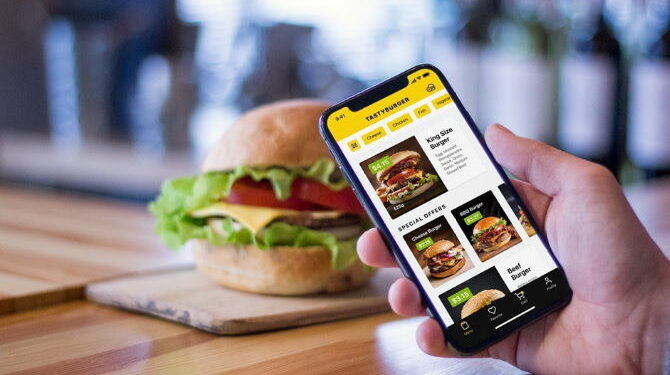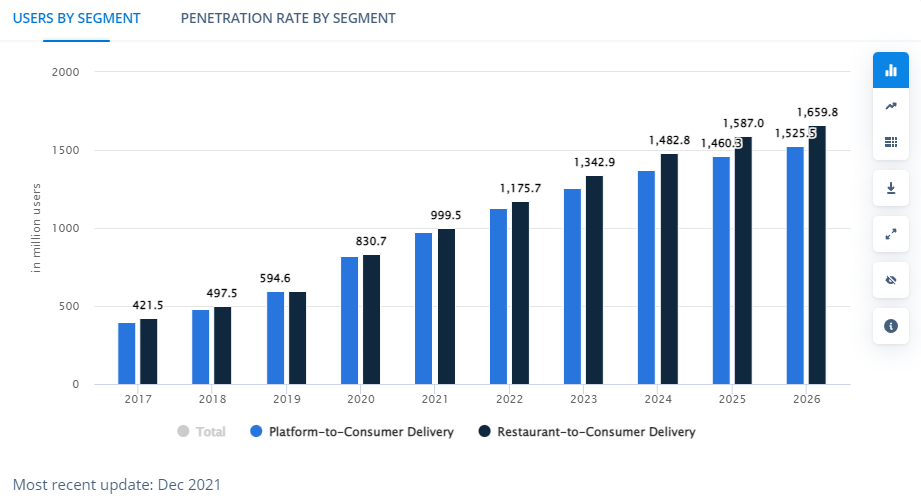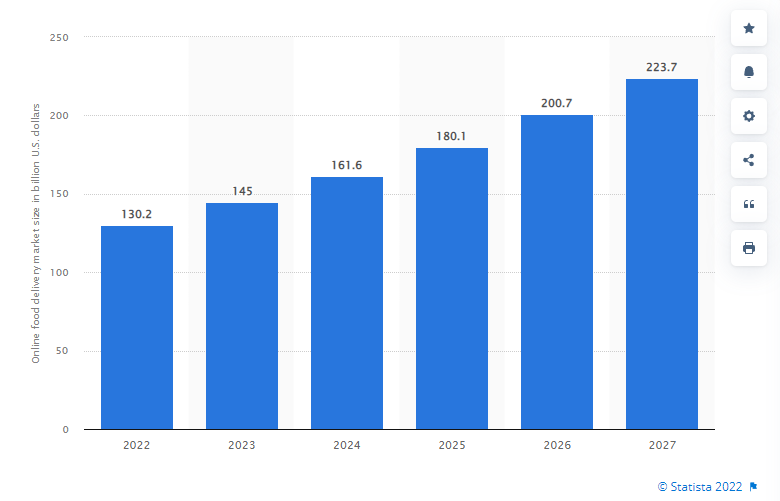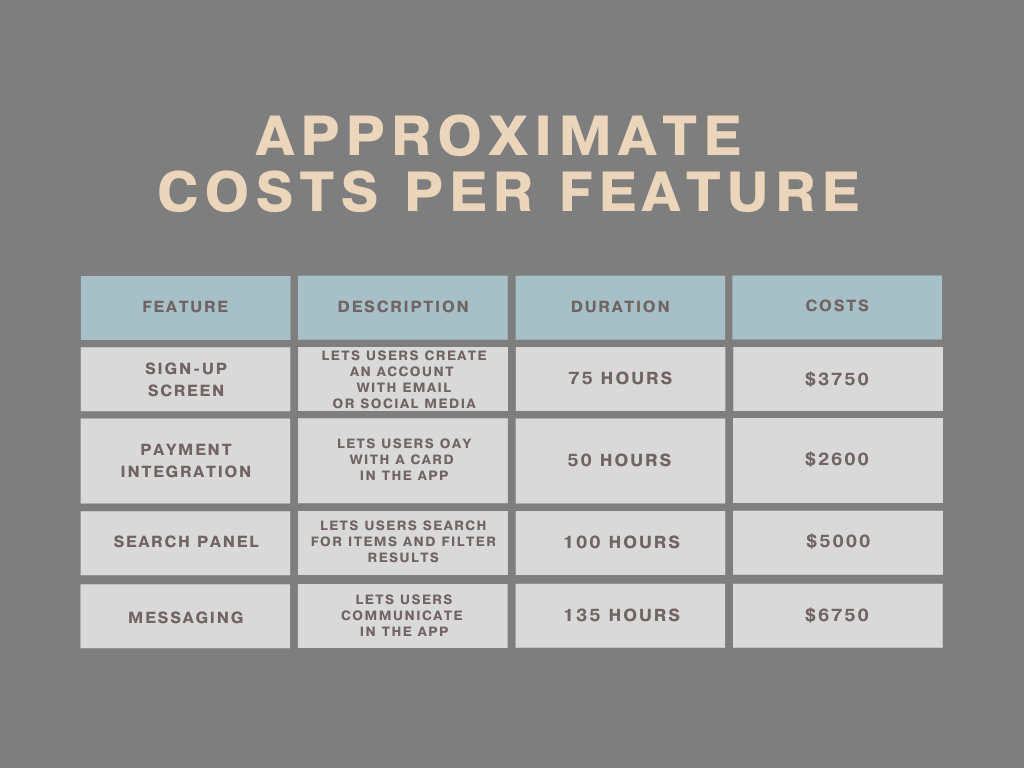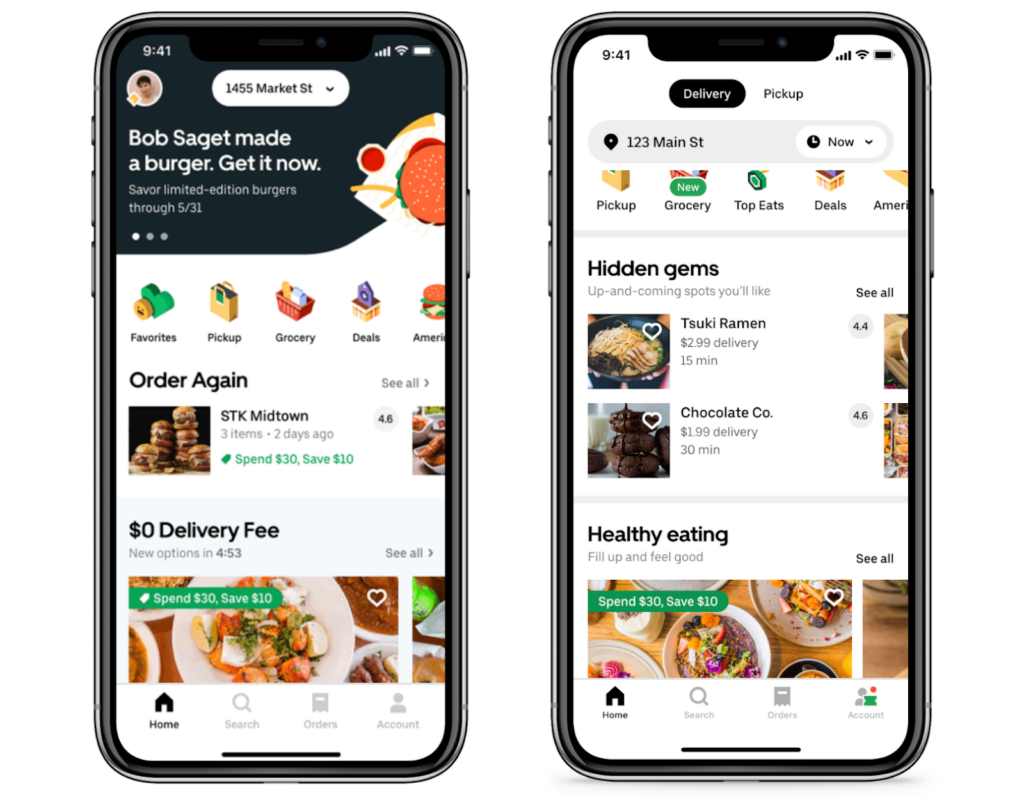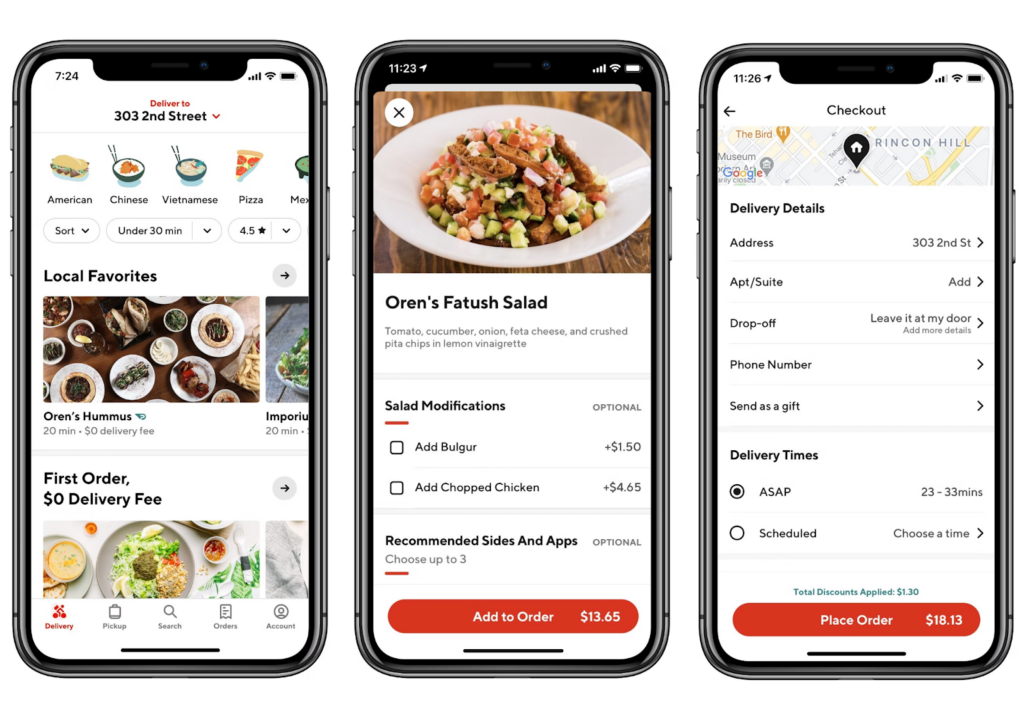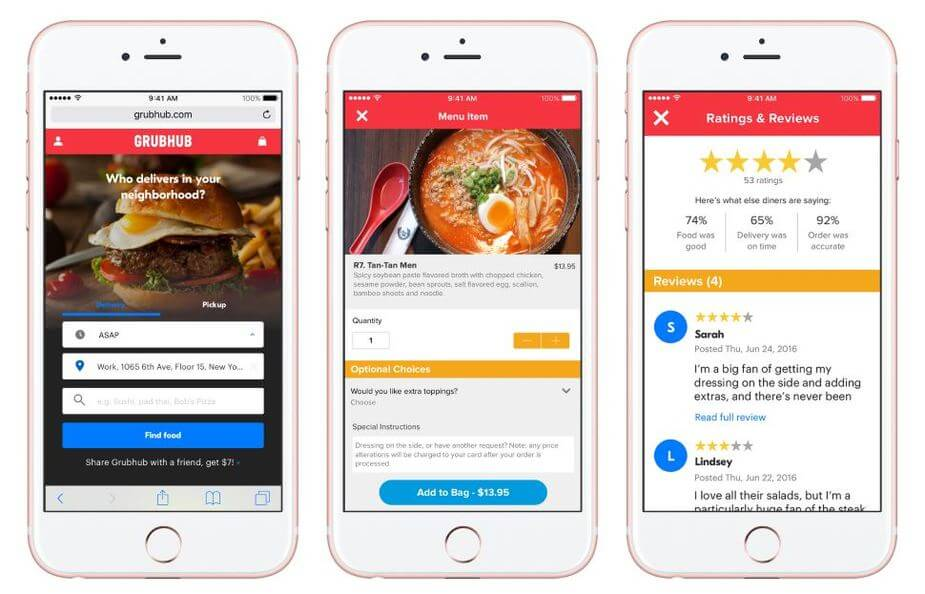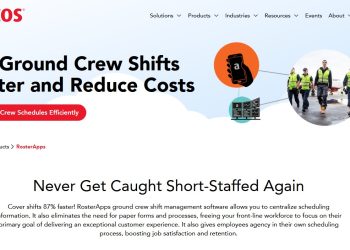When was the last time you ordered food delivery? Probably not so long ago. Recent statistics show that there will be 1.659 billion users ordering food online by 2024. This means that at least every fourth person will be an active participant in this growing market.
As demand for delivery services constantly grows, it is a good opportunity to make a food delivery app of your own. By considering the values of modern users and the flaws of your competitors, you get the chance to cover a decent share of this fast-growing market.
How can you do that? You can start by reading our food delivery app development guide to get an inside-out understanding of the required processes.
Why should you develop a food delivery application?
People always follow the most convenient path. Getting someone to bring a meal to your doorstep is much easier and faster than visiting a restaurant in person, so the extra cost becomes justified.
For example, Grubhub’s general revenue in 2020 totaled $1.8 billion. The company had 31.4 million users at that time. If you think that’s a lot, you’ll be surprised to see that DoorDash earned $4.8 billion with only 25 million users in 2021. The numbers speak for themselves.
According to Statista, there were already 1 billion consumers in the online food delivery market by the end of 2021. The number is projected to grow in the next few years. This shows that we may expect an even higher demand for delivery services, meaning more space for companies to join the market.
We must also note this industry’s expected global market size. It is believed that the food delivery market will grow at a CAGR of 11% from 2022 to 2027, reaching a total value of $223.7 billion by that period. Joining the market now will let you grow simultaneously.
Considering all these key points, we can see that the industry has many prospects. Right now is still a good time to build a food delivery app and get the lion’s share of the global market. Let’s move on to the development features.
Must-have features of a food delivery app
How to start a food delivery app? Analyze the must-have features first. This will give you an understanding of the approximate requirements, costs, and challenges.
Food delivery applications generally involve three parties:
- Clients;
- Restaurants;
- Couriers.
Each requires a separate interface or application with a unique set of features. That’s why we shall cover all categories.
For clients
Clients want to place orders in their favorite restaurants with several clicks. Your task is to make this possible and provide a perfect user experience. The following features will help:
- Account creation. Users must be able to set up a profile and save their information. Authentication should be possible via social media.
- Advanced search. The feature must find matching queries, filter results by different criteria, and show the closest options.
- Order management. Apart from placing orders, users must be able to edit delivery information, choose the preferred time, and select payment options.
- In-app messaging. It is necessary that clients can contact couriers within the app to specify the information or provide additional instructions.
- Location tracking. Customers must be able to see the courier’s location on the map to get up-to-date delivery statuses.
- Pop-up notifications. Users must be notified about changes in the delivery status to see whether the order has already arrived.
- Payment options. It is better when customers can choose whether they want to pay in cash or by card. Gratuity is also a note to consider.
- Feedback. Clients must have the possibility to rate restaurants and couriers after receiving their orders.
These features are the basics to provide a top-notch user experience. You can also think of additional options like gamification features with rewards in coupons and discounts to increase engagement.
For restaurants
Restaurants are interested in generating more revenue and profits with fewer expenses. Therefore, they need the following features to sell their products:
- Account creation. You have to validate the restaurant to prevent fake profiles. After validation, the business can add logos, descriptions, contact details, and other info.
- Menu management. Owners should be able to update their menu at any time. It should include photos, descriptions, and prices.
- Order management. When an order is placed, restaurants must confirm it on their dashboard. They also update the status and get in touch with the client if needed.
- Feedback and ratings. Restaurants should be able to see their clients’ reviews and answer them.
It is not always necessary to create a new application for restaurants. You can add the option to sign in as a restaurant in one product, adding a separate section for them.
For couriers
Couriers want to do their job with minimum obstacles. A feature-rich application can help with that:
- Account creation. Couriers need to set up a basic profile with a name and photo. Also, for security reasons, it is best to include identity verification.
- Booking an order. This lets couriers take orders from nearby restaurants.
- Order information. Couriers should be able to see available orders with the client’s details to choose the most suitable options.
- Delivery status. This lets the courier update the order status: accepted, rejected, picked up, and delivered.
- GPS navigation. It is a necessary feature to ensure couriers easily find the customer’s location.
- In-app messaging. The courier must be able to contact the client or restaurant if any details need to be specified.
- Payment options. You have to determine the ways your couriers get paid. The simplest way is by creating an internal account and letting the couriers withdraw the available money to their bank cards.
- History. A courier must be able to see their order history grouped by dates, customers, and restaurants.
You can motivate couriers to work more efficiently with multiple gamification techniques like challenges and bonuses.
How does food delivery app development work?
The following steps will describe how to develop your own food delivery app.
1. Market research & competitor analysis
First, you start by analyzing the market and understanding your competitors. This process requires thorough research to compile all benefits in one app. Consider the countries you’ll work in and which competitors are already there.
Some other things to note are:
- Target audience;
- Your unique selling point;
- Potential expenses.
You will need an experienced marketer or analyst to do the job.
2. Process planning
If you’re wondering how to make a food delivery app competitive, here’s a quick tip: plan everything before starting the project:
- Create a flowchart for your app;
- Set goals & deadlines for each task;
- Determine the required skills for the project.
Some minor deviations are possible during the process. However, the team will follow the general plan step by step.
3. Platform selection
It is most likely that you will develop software for mobile devices because that’s what the majority of your target audience uses. This is a very tricky part.
You have three types of apps to choose from:
- Native;
- Hybrid;
- Cross-platform.
A native app is the best option if you have a rich budget and seek maximum performance. However, projects with tight budgets will have to use hybrid and cross-platform solutions for food delivery mobile app development.
4. Wireframe creation
One of the steps required to develop an application for food delivery is creating a wireframe. It is the basic visual representation of how the app is expected to look and function.
Here are some tips for creating a wireframe:
- Draw it in a frame with the dimensions of a mobile phone screen;
- Include different screen sizes to ensure appropriate scalability;
- Use design patterns to get reusable content and provide a better UX.
Consider the wireframe as a basic prototype and blueprint for the team to follow.
5. Designing the app
When you create a food delivery app, it’s necessary to understand that design isn’t only about fancy visuals. The design must deliver a seamless user experience. Your designer should ensure the app is intuitive and user-friendly.
A reasonable idea is to check out your competitors’ applications. Identify their pros and cons, read the user reviews, and consider those points when designing your software.
6. Developing the app
The development stage is one of the longest. It covers the selection and implementation of all technologies to ensure the software works with top-notch performance.
Your team will have to determine the:
- Technical architecture;
- Technology stack;
- Development milestones.
Of course, there’s much more than that. Nevertheless, these points provide a general idea of how to create an application for food delivery.
7. Testing
Quality assurance is performed during the development process and after the app is complete. This ensures your software is good from both technical and user standpoints.
Here are the types of testing to consider in custom food delivery application development:
- UX testing;
- Functional testing;
- Performance testing;
- Security testing;
- Compatibility testing.
Covering each type is necessary to ensure you get a bug-free application. Otherwise, you might get an unpleasant surprise after deployment.
8. Release & Maintenance
The last step is publishing your app to Google Play and App Store to make it available for users to download. You will need a developer for both options. Google charges a one-time payment of $25, while Apple has an annual fee of $100.
After deployment, you still have to keep in touch with the development team for maintenance. The application might have a hidden bug or require a new feature. That’s why it is best to keep on collaborating with the people who built the software. They know your app inside-out.
Now that we have covered all 8 steps, you should already know how to make your own food delivery app. Nevertheless, there are still many things to discuss, like costs and examples.
How much does it cost to create a food delivery app?
Food delivery application development comes with multiple costs. The final sum is determined by many factors, which are described below.
Software complexity
The way your app is built and the number of features determine the development costs. There are generally two options:
- An out-of-the-box solution;
- A custom application.
The former is the cheapest version built according to a template and usually has no individuality. The latter, however, can be created any way you want. It has a unique design and set of features. Thus, the costs are higher.
Platforms
We have already mentioned that you can use native, hybrid, and cross-platform applications. Native development is the best option in terms of performance. However, it is the most expensive because you have to write two apps for Android and iOS, respectively.
A cross-platform solution is the cheapest option. Of course, cutting expenses also reduces performance and UX metrics, so you must think carefully when making a choice.
UI/UX design
UI/UX design often determines the success of an application. This includes all buttons, visuals, icons, locations, etc. Creating a top-notch interface that provides a seamless user experience comes at a significant cost.
Back-end infrastructure & APIs
Even the simplest solutions often have a complex set of processes in their back-end. Each process must be optimized. The back-end usually determines the application’s speed, so you don’t want to cheapen out on it.
Another note covers security. There are multiple regulations and standards that must be followed to operate in the European and American markets. A data leak of any size might bring a lot of losses to the company, and that’s something you’d like to prevent.
Company’s location
The location of your development team plays a huge role in the final price. For example, a custom mobile app development company in Eastern Europe would charge $35-60 per hour. Simultaneously, an American company would charge $80-100 per hour, nearly doubling the costs.
The funny thing about this factor is that the developers from Eastern Europe create high-quality software that is sometimes even better than the US counterpart. Thus, the price is determined by the developer’s environment.
Other expenses
Software development in the food delivery industry comes with many additional expenses:
- Application maintenance;
- Marketing;
- Updates;
- App Store fees, and others.
It is necessary to consider these options when setting your budget during the planning stage. Each option is a must because it complements your app.
Build a Food Delivery App Like a Pro: Outstanding Examples
When thinking of how to build a food delivery app that would conquer the market, check out your competitors’ solutions—see what works and what doesn’t and adapt accordingly.
1. Uber Eats
Uber Eats is one of the world’s biggest on-demand food delivery apps. It works in many countries and collaborates with hundreds of restaurants.
Pros:
- Very intuitive design that resembles the original Uber app;
- Has a subscription for monthly delivery services and discounts;
- Convenient order placement.
Cons:
- High service fees and pricing in general;
- Some users report frequent application errors;
- Some users report issues with the app’s support service.
2. DoorDash
DoorDash works in the US, Canada, Australia, and Japan. With only four countries, it still manages to be among the leading delivery apps worldwide.
Pros:
- Intuitive design and simple order placement;
- You can place an order in several clicks.
Cons:
- The GPS navigation feature often does not choose the closest route;
- Some users report issues with the app’s support service.
3. Grubhub
Grubhub is one of the first created food delivery services. Surprisingly, it still keeps the leading position in the global market.
Pros:
- Simple and intuitive interface;
- Fast order placement.
Cons:
- Some users report issues with customer service.
Final thoughts
Now that you know how to create a food delivery app, you should have no trouble understanding the required features and their costs. The numbers show that there is massive potential in this industry, so you still have the chance to get a decent share of the market. Start developing your food delivery app today!

